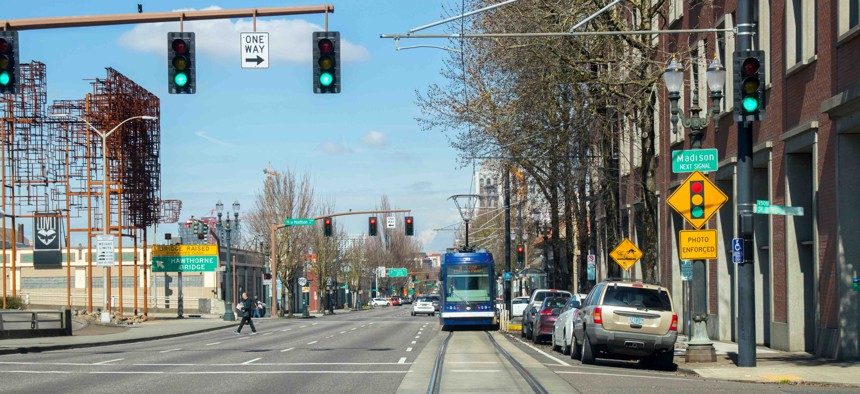After Deadly Crash, Lawsuit Spotlights Problem of Parking Near Intersections

A street in Portland, Oregon. Shuterstock
When cars are parked close to intersections, they can block drivers from seeing other traffic and pedestrians. A lawsuit seeks a court order to force Portland, Oregon to address the issue.
When a vehicle is parked within a few feet of a corner at a city intersection, it can block the line of sight that drivers have to see one another, pedestrians and signs, raising the risk of crashes.
A lawsuit filed recently in an Oregon state court alleges that the city of Portland has failed to adhere to state law and other federal and local requirements that set guidelines for how close to an intersection drivers can safely park their vehicles.
The family of a man who died from injuries sustained in a motorcycle crash in the city last May filed the suit.
Elijah Coe was riding home from work in dry, daylight conditions, traveling on East Burnside Street, when he arrived at the intersection with 17th Avenue. Vehicles on two corners of East Burnside were parked roughly flush with intersection crosswalks, the lawsuit says.
Those parked vehicles, according to the lawsuit, prevented Coe and the driver of a Saab, who had stopped at a stop sign on 17th Avenue and then made a left turn, from seeing one another. Coe swerved to avoid that car, but hit another one head-on.
“Mr. Coe’s death,” the suit says, “could have been prevented if the City complied with the law.” It adds that, “the City’s failure to provide adequate sight distance at intersections endangers people regardless of what mode of transportation they are using.”

Portland’s Bureau of Transportation, according to the court complaint, allows people to park up to the edge of crosswalks at intersections, unless the curb in that area is painted yellow. At the intersection where the crash that killed Coe took place, as on other streets in the city, there was a sign that indicated it was okay to park close to the corner for up to 15 minutes.
The transportation bureau on Monday declined to comment on the case, saying it does not comment on active litigation. The Portland City Attorney’s Office didn’t immediately follow-up on Monday to a phone message asking if it had responded to the complaint.
Oregon has adopted the Manual on Uniform Traffic Control Devices for Streets and Highways, which defines standards for things like road signs, signals and markings. The manual calls for a no parking zone within 20 feet of crosswalks and 30 feet for approaching signals.
The lawsuit also points out that Portland's city code prohibits parking within 50 feet of an intersection if it creates visibility problems. It cites other guidelines as well, which it says the city is not following.

In addition to the city, the lawsuit names the driver of the Saab as a defendant, saying he failed to yield to Coe. The suit seeks up to $5.9 million in damages and also asks for a court order mandating that the city brings its parking rules into line with various safety standards.
BikePortland.org, which covers cycling and transportation issues in the city and was the first to report on the lawsuit, noted that the advocacy group Oregon Walks had been campaigning for Portland to restrict parking near intersection corners.
Relatively high levels of pedestrian and cyclist deaths in the U.S. during recent years have drawn attention to a range of traffic safety issues. Between 2016 and 2018 a total of 123 people died in traffic crashes in Portland, 49 of them, or nearly 40%, were pedestrians.
The lawsuit says that last year alone at least 49 people in Portland died in crashes, including Coe, and that this total is higher than the traffic fatalities the city had in any other year since 1997.
Bill Lucia is a senior reporter for Route Fifty and is based in Olympia, Washington.
NEXT STORY: Maine Voters Consider U-Turn On Vaccine Exemptions






